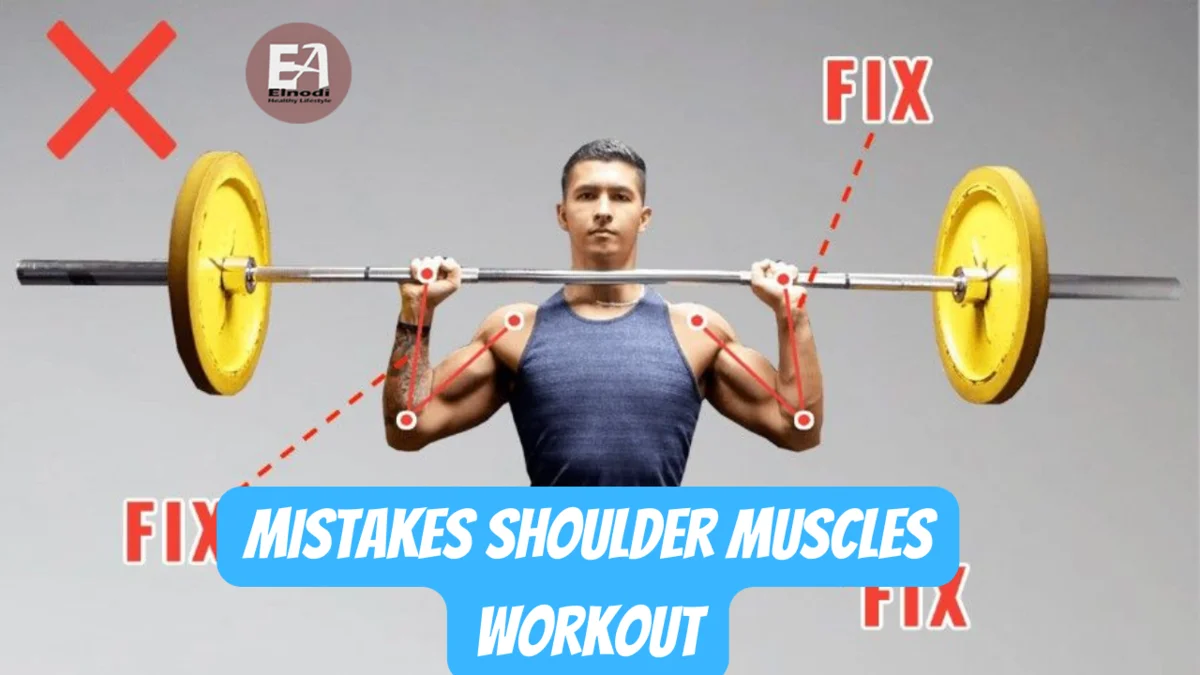Are you looking to build strong and healthy shoulders? If so, you need to avoid making these shoulder muscles workout common mistakes.
If you want to build strong and healthy shoulders, it is important to avoid making common mistakes. In this blog post, we will discuss mistakes that can lead to injury and prevent you from achieving your fitness goals. We will also provide tips on how to avoid these mistakes and improve your shoulder workout results.
benefits of Shoulder Muscles Workout

Improved strength and stability. Strong shoulders help you perform everyday activities with ease, such as lifting objects, carrying groceries, and opening doors. They also help to stabilize your upper body during exercises, such as push-ups and pull-ups.
Increased range of motion. A shoulder muscles workout can help to improve your range of motion, which can make it easier to do things like reach overhead, put your hands behind your back, and even brush your hair.
Reduced risk of injury. Strong shoulders help to protect your rotator cuff, which is a group of muscles and tendons that help to stabilize your shoulder joint. By strengthening your shoulders, you can help to reduce your risk of rotator cuff injuries.
Improved posture. Strong shoulders can help to improve your posture by pulling your shoulders back and down. This can make you look and feel taller and more confident.
Enhanced appearance. A shoulder muscles workout can help to build muscle and definition in your shoulders, which can give you a more athletic and attractive physique.
If you’re looking for ways to improve your strength, stability, range of motion, and overall health, then shoulder workouts are a great place to start. With regular exercise, you can see significant results in a relatively short period of time.
Mistakes Shoulder Muscles Workout
#1 OVEREMPHASIZING FRONT DELTS
All delt heads do not work equally, and the anterior delt head normally carries the most weight. Not only are your front delts key movers during overhead presses, but they’re also secondary movers throughout chest and triceps workouts, assisting with presses and dips. You’re probably overworking your front delts if you do front raises in addition to a lot of shoulders, chest, and tri-complex movements. This is especially true if you train your chest and shoulders at the same time or on the same day.
#2 UNDEREMPHASIZING REAR DELTS
Just as anterior delts are overemphasized, posterior delts are underemphasized. Rear delts help with lat movements like rows and pulldowns, but if you’re targeting your lats correctly, your rear delts are unlikely to get enough work on back or shoulder day to reach their full potential. Most bodybuilders save the rear laterals for last in their shoulder routines and then go through the motions for four sets of four reps. It’s no surprise that your posterior delts are typically the weakest link in your shoulders.
#3 TOO FAST AND FURIOUS
Trainers often go too heavy and use too much momentum when performing side laterals and front lifts. Each delt head is relatively small, therefore you must decrease both momentum and help from other muscles in order to isolate them. You may not want to be seen with 20-pound dumbbells, but if that’s what it takes to isolate your medial delts, those are the weights to use.
# 4 IMPROPER FORM
This error is frequently made in conjunction with #3. The main problem is a concentration on weight rather than muscle stimulation. As a result, the weight is increased by all means required. Trainers can sometimes establish undesirable habits; some never learn how to conduct lifts in a way that promotes muscle growth. Because of the sensitivity of the ball-and-socket joints to injury, proper form is especially critical on shoulder day.
#5 LACK OF EXERCISE VARIETY
Shoulders may be the only body part you train with just free weights. It’s true that barbells and dumbbells are the most effective training tools, but you can too easily fall into a rut of doing the same three or four free-weight exercises the same way, workout after workout. Variety is also an effective tool.
#6 Lifting with your neck.
Your neck is not designed to support the weight of a barbell or dumbbell. When you lift with your neck, you’re putting stress on your spine and shoulders. Instead, focus on lifting with your shoulders and upper back
#7 Ignoring pain.
If you feel pain during a shoulder workout, stop immediately. Pain is a sign that you’re doing something wrong. If you ignore pain, you could make the injury worse.
How to prevent shoulder injuries
Shoulder injuries are a common occurrence, especially among athletes and people who participate in overhead activities. However, there are a number of things you can do to help prevent shoulder injuries.
Here are some tips on how to prevent shoulder injuries:
- Use proper form. This is the most important thing you can do to protect your shoulders. Make sure you’re using the correct form for each exercise, and don’t be afraid to ask for help from a qualified trainer.
- Listen to your body. If you feel pain, stop the exercise immediately. Don’t try to push through the pain, as this could make the injury worse.
- Warm up properly. A good warm-up will help to prepare your shoulders for exercise and reduce your risk of injury.
- Cool down properly. A cool-down will help to reduce inflammation and soreness in your shoulders.
- Stretch regularly. Stretching will help to improve your range of motion and flexibility, which can help to prevent injuries.





